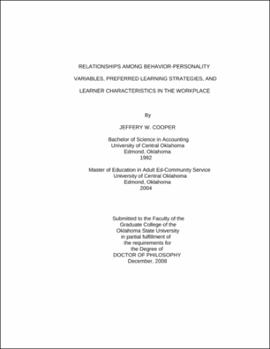| dc.contributor.advisor | Ausburn, Lynna J. | |
| dc.contributor.author | Cooper, Jeffery W. | |
| dc.date.accessioned | 2013-11-26T08:34:20Z | |
| dc.date.available | 2013-11-26T08:34:20Z | |
| dc.date.issued | 2008-12 | |
| dc.identifier.uri | https://hdl.handle.net/11244/7355 | |
| dc.description.abstract | Scope and Method of Study: The purpose of this study was to describe the behavior/personality and learning strategy profiles and their relationships among individuals in the corporate workforce in Oklahoma. The study was descriptive and used a self-report questionnaire methodology. The concept of needs-driven behavior/personality was measured with the DiSC Personal Profiles System 2800 Series. The concept of preferred learning strategy was measured with Assessing the Learning Strategies of Adults (ATLAS). Data were also collected on six demographic variables. The sample consisted of 124 participants from financial, information, and manufacturing industries in Oklahoma City, OK. | |
| dc.description.abstract | Findings and Conclusions: The behavior/personality profile of the workforce participants indicated approximately 70% of the participants clustered in 5 of the 16 identified profile patterns for the DiSC. Chi-square analysis of the learning strategy profile indicated that the distribution of this sample was different from the ATLAS norms. Crosstab analysis for DiSC by the demographic variables indicated a statistically significant relationship for DiSC by Age (p =.047). Crosstab analysis for ATLAS by demographic variables indicated a relationship for ATLAS by Industry (p =.068) that warrants further research. Cluster analysis revealed that the most appropriate solution for describing the participants in this study was a 3-cluster solution. Discriminant analysis identified the three cluster groups as: Cognitive Leaders, Affective Leaders, and Team Members. Crosstab analysis for the clusters by other variables indicated a statistically significant relationship for Clusters by Education (p =.009). Based on the findings, the following conclusions were drawn: (1) DiSC and ATLAS may measure discrete and unique constructs, (2) The relationship between preferred learning strategy (ATLAS) and personality/behavior (DiSC) may be complex and may require further study to evaluate, (3) Individuals in the sampled industries showed strong preference for five of the DiSC Classic profiles, and distribution may not be uniform across industries, (4) DiSC profiles may be related to age generations as defined by Strauss, (5) Preferred learning strategy may be related to industry in which employed and may not be uniform across industries, (6) There may be dissonance between workers' identified work roles and their preferred work roles, and (7) Work roles and preferences may be related to level of education attained. | |
| dc.format | application/pdf | |
| dc.language | en_US | |
| dc.rights | Copyright is held by the author who has granted the Oklahoma State University Library the non-exclusive right to share this material in its institutional repository. Contact Digital Library Services at lib-dls@okstate.edu or 405-744-9161 for the permission policy on the use, reproduction or distribution of this material. | |
| dc.title | Relationships among behavior-personality variables, preferred learning strategies, and learner characteristics in the workplace | |
| dc.contributor.committeeMember | Conti, Gary J. | |
| dc.contributor.committeeMember | Harris, Ed | |
| dc.contributor.committeeMember | Self, Mary Jo | |
| osu.filename | Cooper_okstate_0664D_10045.pdf | |
| osu.accesstype | Open Access | |
| dc.type.genre | Dissertation | |
| dc.type.material | Text | |
| dc.subject.keywords | atlas | |
| dc.subject.keywords | behavior/personality | |
| dc.subject.keywords | disc | |
| dc.subject.keywords | learner characteristic | |
| dc.subject.keywords | learning strategy | |
| dc.subject.keywords | u.s. workforce | |
| thesis.degree.discipline | Occupational Education Studies | |
| thesis.degree.grantor | Oklahoma State University | |
